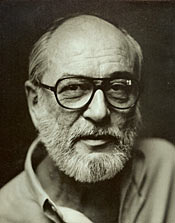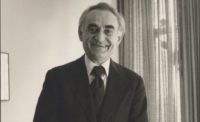 Photo by John Brooke, courtesy Irene Jenks |
Charismatic, daring, artistic. We don’t always associate these qualities with structural engineers, but the highly esteemed Bill LeMessurier, who passed away June 14 at the age of 81, embodied all of them.
Trained as an architect at the Harvard Graduate School of Design, LeMessurier graduated from the Massachusetts Institute of Technology with a master’s degree in building engineering and construction in 1953—“then all his [Harvard] classmates hired him,” remembers his wife, Dorothy, who married him the same year.
Indeed, since LeMessurier started his eponymous practice in 1961, he distinguished himself with a sensitivity to architects’ aspirations. “He was a real collaborator—he understood what an architect was trying to do, and was better able to respond to architects’ needs than the normal structural engineer,” says Mysore Ravindra, president and principal structural engineer of LeMessurier Consultants.
Ravindra points to the Federal Reserve Bank of Boston and New York’s iconic Citicorp building, both designed by architect Hugh Stubbins, as prime examples of LeMessurier’s understanding of architecture: “Bill came up with structural systems that suited the architects, but that other engineers would have hesitated to design.” Working with colleagues at MIT, for example, LeMessurier invented a staggered truss system to carry a tall building’s gravity and wind loads, have many advantages over conventional steel frame structures, including large column-free spaces. Staggered trusses are still widely used in hotel and condominium construction. To increase tenants’ comfort level in the lightweight Citicorp tower, LeMessurier used a tuned mass damper: a first for skyscraper design.
But LeMessurier’s daring and innovation sometimes came with a price. He later admitted to a series of misunderstandings that resulted in the 1977 Citicorp Center tower’s lack of reinforcing for quartering winds—leaving it vulnerable to collapse in a hurricane-force storm. The building’s structural system underwent extensive structural repairs during the summer of 1978. These did not become known to the public until 1995, when The New Yorker published an article detailing the saga.
In addition to his engineering consultancy, LeMessurier taught at both alma maters. His lessons captured the aesthetic appreciation, boldness, and social responsibility of his practice—and his equally outsize personality. “I remember well the first day of class,” Scott Simpson, FAIA, now senior principal at KlingStubbins, recalls. “Bill arrived, a bit late as usual, and addressed the first-year class: ‘Gentlemen,’ he said, ignoring the women in the room, ‘You’ve come to Harvard to learn how to be great architects and run your own firms someday. Hence, my job is not to teach you structural engineering. My job is to teach you how to have lunch with your structural engineer!’”
After retiring from LeMessurier Consultants in 1991, LeMessurier continued teaching at both Harvard and MIT until 2003, when, his wife says, an advancing case of Alzheimer’s obliged him to step down. While recovering from hip surgery on June 1, he developed an embolism that caused his death. Dorothy LeMessurier says that a memorial service is tentatively scheduled for October 13 at the Harvard GSD.




Post a comment to this article
Report Abusive Comment